High-yielding, unpretentious table potato variety "Innovator"
The Innovator variety appeared on the Russian market more than 10 years ago. Due to its resistance to unstable weather conditions, it is widespread in different regions of the country.
This high-yielding table potato is notable for its marketability, is one of the ten best varieties for baking, and is immune to many nightshade diseases.
The content of the article
Description of the variety
Potatoes The innovator is distinguished by high yield rates, unpretentious care, good taste.... Medium-sized farms use it as the main representative of the crop for cultivation - because of its good keeping quality.
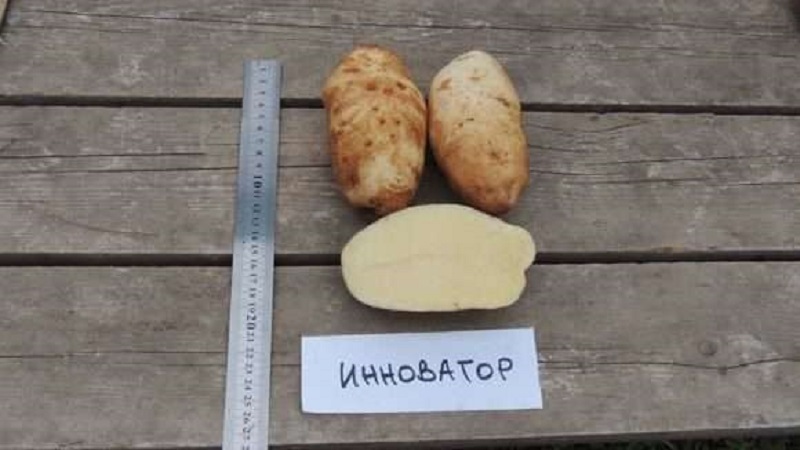
Origin and development
Innovator bred by Dutch breeders... The new variety was intended for commercial production, but is also grown on personal plots.
Chemical composition, trace elements and vitamins
100g Potatoes (% DV) contains from 12 to 15% starch... It contains:
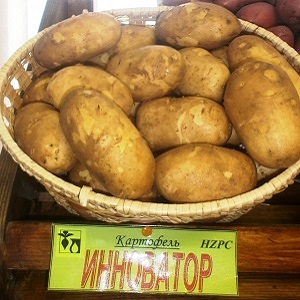 ascorbic acid - 24%;
ascorbic acid - 24%;- boron - 164%;
- vanadium - 373%;
- vitamin K - 13.3%;
- iron - 15.5%;
- potassium - 23%;
- cobalt - 50%;
- silicon - 167%;
- lithium - 77%;
- manganese - 16%;
- copper - 14%;
- molybdenum - 11%;
- pyridoxine - 15%;
- rubidium - 500%;
- folic and nicotinic acid - 10.5% each;
- oxalic acid - 7.8%.
Important! The composition of tubers includes nonessential and irreplaceable amino acids, saturated and unsaturated fatty acids, purine bases. The purine volume in 100 g is 5% of the daily value, which should be taken into account by patients with gout.
Ripening period
Potatoes belong to the middle early group... The full ripening of the variety takes 75-85 days. The first digging for pre-germination before planting is carried out on day 70.
Yield
With proper fit and compliance, you can get: on farms from 320 to 330 c / ha, on private plots - from 15 to 30 kg / m2... The maximum volumes of potatoes were harvested in the Kirov region - 344 c / ha. Each bush has from 6 to 10 tubers.
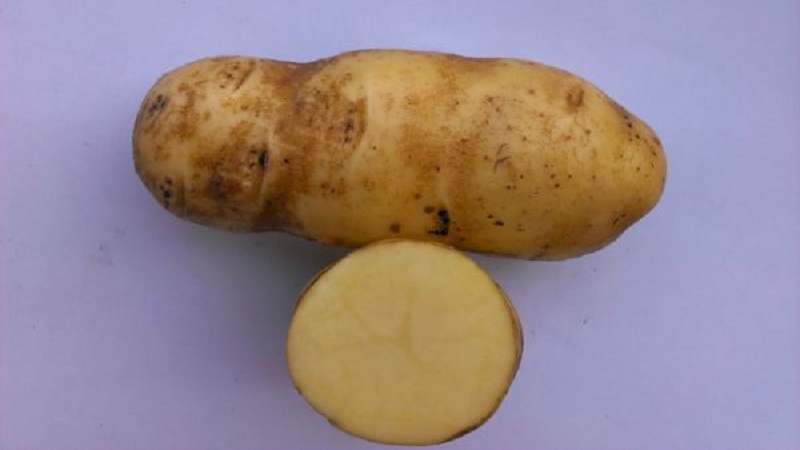
Disease resistance
The cultivar has genetic immunity to potato crayfish and potato pale nematode. Average resistance was noted in relation to scab and late blight. Potatoes need protection from rhizoctonia disease.
Interesting on the site:
High-yielding, frost-resistant potato "Zhuravinka"
Characteristics of tubers, description of appearance
The Innovator has an oblong and oval tuber shape weighing 83-147 g... Light yellow peel with a slight roughness, flat and small eyes. The pulp is light cream in color with a dense structure. Potatoes retain their color after cooking and are poorly boiled.
For which regions is best suited and demanding on the climate
The Innovator variety is recommended for planting in the Central, Volgo-Vyatka, Central Chernozem regions.
Potatoes easily withstand a drought that is short in time, suitable for planting in the southern steppe regions, and became widespread in Siberia.
The main advantages and disadvantages of the variety
The advantages include increased drought resistance and the absence of special requirements for the soil.
Specialists highlight the following advantages:
- at the time of transportation, chips, darkened spots and scratches do not appear on the tubers;
- shows good results when grown from seeds;
- used by processing industries.
The disadvantages include susceptibility to certain diseases. The problem is solved with the help of preventive measures.
What is the difference from other varieties
The difference between the Innovator and other species is the absence of increased requirements for irrigation and soil. Potatoes are resistant to mechanical damage. Easy transportation with minimal losses and high yield have become the hallmark of the variety.
Features of planting and growing
For maximum yield follow the rules of preliminary preparation for planting work, take into account the peculiarities of care. Violation of the standards will negatively affect the amount of potatoes. Lack of feeding and insufficient watering will lead to the appearance of small tubers of an unmarketable type.
Preparing for landing
Preliminary work for obtaining a very early harvest begins 40-50 days before planting.
The algorithm of actions is simple:
- seed potatoes are laid out in boxes in an even layer of 2-3 cm;
- sprayed with water up to twice a day;
- the first week observe the temperature regime at 18-20 ° C;
- in the second week, reduce the temperature to 15-17 ° C;
- after 21 days, culling is performed: tubers with a formed peel and sprouted eyes are suitable for planting.
Selected potatoes are laid out in boxes with humus, poured 3-4 cm in thickness, sprouts up. Sprinkle with peat on top, then begin to form a new level. The maximum number of staged stacks in one box should not exceed four rows. Moistening is carried out with a solution of mineral fertilizers.
Ground requirements
Preference is given to slightly acidic or neutral soil reaction... The best yield indicators were noted when collecting tubers from sandy and sandy loam soil. A bucket of sawdust or sand per m is brought into clay soil2... Reducing the level of soil acidity is carried out with dolomite flour or lime.
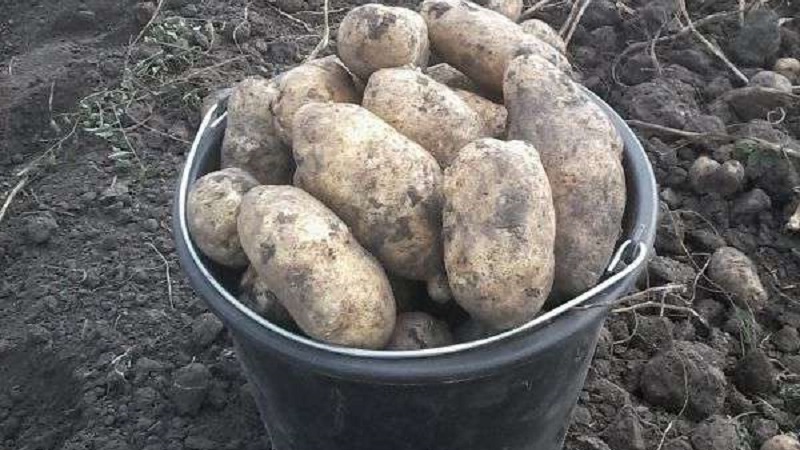
Timing, scheme and landing rules
A month and a half before the seasonal work, the potatoes are sorted out, germinated. For Russian climatic conditions own requirements:
- planting works take place in May, at a soil temperature of 7 ° C;
- distance between rows from 70 to 75 cm;
- before planting, organic or complex fertilizers are applied to each hole;
- seed material is planted to a depth of 8 to 10 cm - on heavy soils, on light soils - up to 15 cm.
Important! The gap between the holes should be 35 cm. Before planting, pay attention to the soil moisture indicators. Since autumn, compost, superphosphate, humus are introduced into the ground, and they are thoroughly plowed.
Growing features
Despite the pronounced resistance to drought, the variety requires timely moistening of the earth... Particular attention is paid to planting in hot summers or in regions with an arid climate. Loosening, weeding of weeds, hilling, feeding are periodically carried out. The frequency of the procedures depends on the characteristics of the soil, weather conditions.
The nuances of care
The innovator is unpretentious... You cannot count on a decent harvest without watering, pest and disease control, and weeding. Proper maintenance will reduce the number of small tubers per bush.
Watering mode
The first soil moistening is carried out during the formation of buds, secondary - after flowering. In the future, watering should be moderate, the frequency depends on weather conditions. Excess moisture can cause rot infestation of tubers.
Read also:
High-yielding potato variety "Ermak" with pinkish skin
Unpretentious early ripe potatoes "Lyubava" for long storage
Top dressing
Common fertilizers include:
- bird droppings - diluted with water in a ratio of 1 to 10;
- urea - for 10 liters of liquid take 1 tbsp. a spoonful of the substance, poured at the root, preliminarily loosen the soil a little;
- mullein - 10 liters of water are taken per liter of fresh manure.
Top dressing is carried out between the rows... Mineral fertilizers are applied in spring, observing the proportions indicated on the package. Excessive intake of nutrients can adversely affect the yield, cause the death of plants.
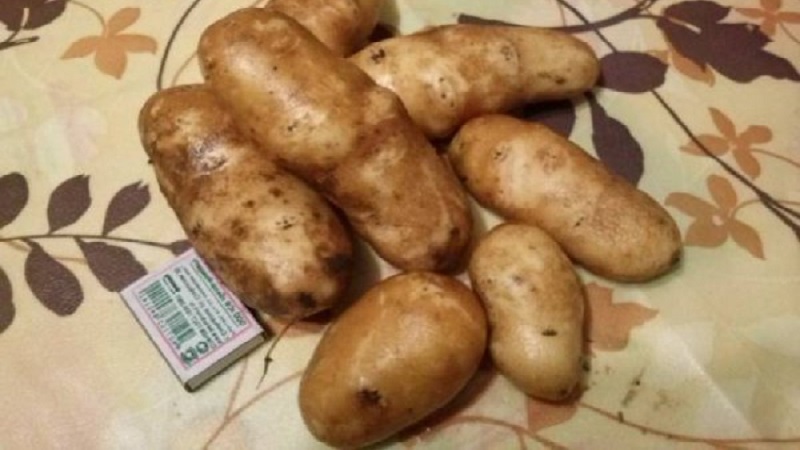
Weeding and hilling
Loosening of the soil is carried out at least three times per season. Hilling is recommended after rains or watering:
- the first time - 2-3 weeks from the day of planting;
- the second - in the same period after the primary processing;
- the third - a week before flowering.
Attention! Constant loosening of the soil can cause a decrease in the amount of the crop due to overheating of the underground part. In this state, the plant is more often affected by scab.
The frequency of weeding depends on the type of planting: if previously germinated tubers were used, then the procedure takes place three weeks after planting seedlings and before flowering bushes. In the case of using seed, as the weed grows, sometimes the first cleaning of weeds is done before the first sprouts of potatoes appear.
Disease and pest control
Works are performed depending on the type of lesion. Late blight is destroyed by spraying copper sulfate - two weeks after germination. To prevent the development of rhizoctonia, seed is treated with a 1% boric acid solution before planting; Ditan M-45 (80%) can be used.
Powdery scab requires spraying tubers with 5% copper sulfate solution. If the site is attacked by the golden potato cyst nematode, then the tops and plant residues are burned, and the next potato planting is allowed only after four years. The fight against the Colorado potato beetle consists in pollination of plants with insecticides.

Harvesting and storage
Correctly carried out harvesting work guarantees the safety of tubers, their presentation. Failure to collect collection requirements will result in massive rotting... The increased humidity in the storage will provoke the spread of the fungus.
How and when to collect
Before harvesting, you need to make sure that the potatoes are technically mature. A thick skin should form on the tubers - with it the harvest will be stored longer. Harvesting is carried out in dry and sunny weather, tubers are in the beds until the evening. The next three days they are left in the shade in the fresh air.
After drying, the potatoes are sorted, laid out in boxes and sent to basements, cellars. The exact harvest date varies by region. Preference is given to the last days of August and early September.
Storage features and keeping quality of the variety
The safety of the variety reaches 95%, it has an average dormancy... The storage time is up to four months, which is an excellent indicator for early potatoes. Before being sent to the basement, the potatoes are sorted out, sorted into tubers into small and large ones, treated with anti-fungus agents, and laid out in different boxes.
For better preservation of the Innovator, a dark, frost-free basement is used. with a stable temperature + 2 ... + 3 ° C, humidity 70-85%. When storing in boxes, stands are used, which are placed 15 cm from the floor, away from the walls.
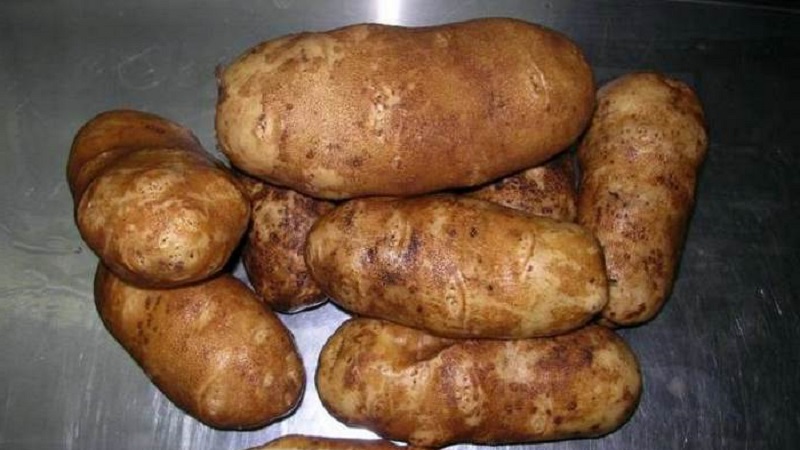
What can be the difficulties in growing
The main problem with caring for a variety is excessive moisture due to too frequent watering.... Excess water can cause rotting potatoes. An excess of feeding provokes a stop in the growth of bushes, their death, and improperly prepared tubers are attacked by pests and diseases.
Violation of crop rotation requirements leads to poor plant growth, small potatoes, reduced yield.
Tips from experienced gardeners and reviews about the Innovator variety
Professional agronomists advise to adhere to standard recommendations for feeding, watering, hilling, mulching potatoes Innovator... Before planting, you need to do a soil analysis, normalize the indicators to a neutral level, process the seed and soil.
Anton Nikolaevich, Ryazan region: “The Innovator was growing the next year after white cabbage. I sowed 12 hectares, got a good harvest, most of which I sold. The commercial quality is high, I used only organic fertilizers for feeding ".
Anatoly, Moscow region: “I have been growing this variety for the third year in a row, now from my own seeds. I use organic fertilizers between the beds. Diseases and pests were bypassed, potatoes please with large tubers and excellent taste. ".
Conclusion
The Innovator variety is used not only by gardeners, but also by farms. Large yields, unpretentiousness and the possibility of long-term storage allowed it to quickly spread across the territory of the Russian Federation, Ukraine and Moldova.